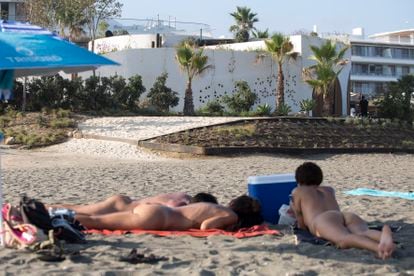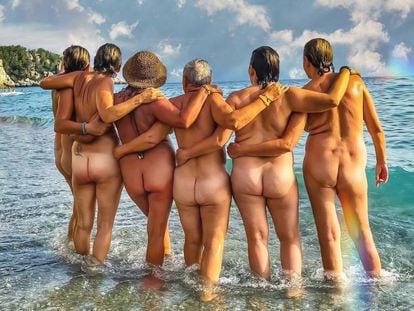Why nudists are being pushed out of Spain’s beaches
Mass tourism, pressure from urban development and the ubiquitous cellphone camera are all working against naturists who are calling for the practice to be respected
/cloudfront-eu-central-1.images.arcpublishing.com/prisa/S7YDUGXI3BHAZAYHXKINADY4HY.JPG)
To the west of Ibiza, in the municipality of Sant Josep de sa Talaia, a town of 27,413 inhabitants, there is a tiny beach that lies at the foot of a cliff, officially known as Es racó d’en Xic. Unofficially, it is called Cala Escondida, which is the name of the beach bar that opened there seven years ago. An ecological establishment, the bar has just a handful of dishes on its menu as well as exquisite passionfruit cocktails, and allows patrons to dine naked at its clutch of tables. Nudism is popular on this idyllic sandy beach in Spain’s Balearic Islands. “Everyone goes as they please,” says Tess Harmsen, who runs the bar and who has noted that the practice of nudism is on the wane. “Before it was common to see people without clothes at the tables, but now they are the exception. It’s the same on the beach.” Originally from the Netherlands, Harmsen is not the only one to notice naturism’s downturn; the situation is the same along most of the Spanish coast, according to various naturist associations consulted by EL PAÍS. The crowds of tourists, pressure from real estate developments and the omnipresence of cellphone cameras are some of the main factors behind the decline.
In Spain, there are about 450 nudist beaches as well as various public swimming pools and stretches of marshland or riverbanks specific to the practice, according to the Spanish Federation of Naturism (FEN). But Ismael Rodrigo, the FEN president, points out it is “perfectly legal” to go without a swimsuit or bikini on any of the more than 3,000 beaches throughout the country. The Costa del Sol in the south of Spain and Ibiza were pioneers in this respect, even during the Franco dictatorship, and became synonymous with nudist beaches.

Patricia Soley-Beltrán, an anthropologist who studied at Barcelona University and has a PhD in Gender Sociology from Edinburgh University, explains that going topless gained momentum in the 1980s and was not just a gesture of freedom, but also a way for women to assert themselves. “They were saying in effect that we are masters of our own bodies,” says Soley-Beltrán, whose book Divinas! Modelos, Poder y Mentiras (or, Divine beings! Models, Power and Lies) was published in 2015. Nudism was also a way of connecting with the body, having contact with nature, promoting respect for the environment and stripping nakedness of the sexual connotation that advertising insists on giving it.
“It’s something that doesn’t sit well nowadays with the crowding on the beaches,” says Soley-Beltrán. “You’re made to feel uncomfortable if you don’t wear a swimsuit. And in the end, you hold back. I don’t want my breasts to create an awkward situation for anyone. Nowadays, there’s competition to show off your sculptured body in the latest model of bikini. As a result, nudism has gone into decline. And I think that is really a shame.”
The average age of nudists is also changing: for upcoming generations, the practice does not have the same symbolic appeal of female empowerment that it had in its heyday. A survey by the French polling and market research firm IFOP found that 20% of Spanish women had been totally naked on the beach at least once in 2019. In 2016, that figure stood at 25%. The figure for topless bathing dropped from 49% in 2016 to 48% two years ago.
In the past, enclaves such as Es racó d’en Xic in Ibiza were known only to the select few, but in the age of Instagram, thousands flock here. Most wear clothes and are unaware of the beach’s naturist tradition, indicated by nothing more than a sign painted on a rock. “In high season, most people wear clothes and people are shy about it [going naked],” says Harmsen. “Those who do go naked feel they are being stared at or remarked upon and that makes them feel self-conscious.”
In addition to mass tourism, nudism is also being hindered by urban sprawl. Marbella and its surroundings, which have seen rampant urban development, are a prime example. “Real estate development is our main enemy,” says Julio Romero, a regular on the Costa Natura beach in Estepona, a beach town of 68,286 inhabitants in the Málaga province. In fact, the opening of the exclusive Nido beach bar in Costa Natura in July appears to be threatening the practice of nudism in a spot that pioneered it. “No one was ever forced here to either wear a bathing suit or not,” adds the 54-year-old. “What they can’t do is throw us out for not wearing one, which is what they are trying to do.” In response, Albert Beniflah, who runs Nido, says: “There was nothing here before, but things change. That’s life.”
The controversy in Estepona is not unique. On the Costa Brava, 1,100 kilometers away, a similar scenario is unfolding. Begur, a tourist town of 3,925 inhabitants in the province of Girona, is home to Catalonia’s naturist gem, the Illa Roja cove. The reopening this summer of a beach bar that had been closed since 2004 has caused tension between the new owner, the nudists and those who wear swimsuits. The nudist association Club Català de Naturisme filed a complaint at the beginning of August against the beach bar for not wanting to serve naked customers, a line it felt to be discriminatory. “In the old bar, there was no problem, and even the waiters went naked,” says Segimon Rovira, the president of the organization. “Now we are losing ground.” But bar owner David Maronda believes he has the right to dictate the dress code. “I am an absolutely tolerant person and I have always lived in Begur,” he says. “I am familiar with the philosophy of the beach and I respect it. But it seems surreal to me that they complain about a request to wear a simple sarong.”
The situation is very different in Benalnatura, a small beach at the heart of Benalmádena, a town of 68,128 inhabitants in Málaga. Next to the stairs providing sole access to the area, there are signs indicating it is a nudist beach and another sign that states: “The bar will not serve anyone dressed or wearing a swimsuit.” On August 26, at 10am, about 30 people were already enjoying the beach’s turquoise waters. Among those consulted, no one wanted to be identified or trigger any kind of controversy, but they made it clear that they do not tolerate clothed beachgoers. “We start clapping until they leave,” says a man in his 60s. The City Council has not received any complaints from non-nudists in this regard, according to municipal sources. But according to FEN, this is an isolated case and should not be considered the norm, pointing out that such a practice is “illegal” in the same way as it is, in their opinion, illegal to stop nudists using sun loungers.

Further east, on the beach of Cantarriján, in Almuñécar, a town of 26,377 inhabitants in the province of Granada, there is no such problem. A traditional naturist destination in the middle of a Natural Park, nudists and non-nudists coexist in perfect harmony. And in its two beach bars, there are no objections to nudists using the sun loungers while in one, La Barraca, nudism has been allowed in at least part of its outdoor dining area since 2018. “In general, there is a very good atmosphere,” says Pedro Pérez, secretary of the Association of Friends of the Cantarriján Nudist Beach (AAPNC) that has 100 members. “But it is true that, in high season, in the middle of summer, there is far less nudism.”
Referring to the summer crowds, a 28-year-old from the Balearic Island of Formentera, says: “You lose the sense of intimacy.” In July and August, she herself keeps her bikini on as the number of clothed beachgoers multiplies and the naturist tradition brought in the 1960s by those known as els peluts (the hairy ones) is outnumbered. Two of these 1960s pioneers starred in the cult classic More, the directorial debut of Barbet Schroeder, shot in Formentera and released in 1969, much of which shows them naked either in the sea or at home.
Naturists like Pedro Pérez believe the practice of nudism brings only benefits: a sense of freedom, the comfort of avoiding wet clothes, hygienic advantages. “You have to try it. It’s addictive,” he says. He ditched his swimwear when he was 17 and is now 47 years old. In these three decades, he has seen nudism go into decline.
Naturist associations say there are many reasons for this trend. Firstly, advertising and beauty stereotypes have instilled fear of revealing imperfect bodies. “But being naked, seeing other real bodies, helps to eliminate complexes,” says Pérez. “We are all just made the way we are.” According to child psychologist Jesús Paños, “naturism can help improve our body image.”
The second reason concerns worrying about what others think. “Part of society always sexualizes nakedness. And that raises doubts in many naturists, such as what will they think of me at work or in the family,” says Pérez. “Upbringing has a lot to do with it because we are taught which parts of our bodies to cover up.” Pérez also points out there is censorship regarding nudism on social media – for example, the censorship of the female nipple, “with the implication that showing it is wrong.”

The fourth factor concerns the ubiquitous cellphone camera. In the age of the selfie, it is difficult to know what the “photographer” is focusing on. “There can be confusion,” says FEN’s Segimon Rovira. The fear is that a stolen image, mainly of women, could end up on internet forums or in pornographic websites, which can have specific sections displaying illegally taken images from beaches. To avoid exposing themselves to this risk, many naturists prefer to go to coastal areas where only nudists go. However, Julián Santamaría, 53, from Gran Canaria, who runs the Canudists association, says: “I usually go to the closest beach or the one I feel like going to. You have to respect the fact that everyone can go as they please.”
Santamaría has had a few brushes with the local police and those who do not understand why he prefers to go nude. He blames this on the ignorance surrounding nudism, which is legal on any beach, and also any river and park and even in the street. However, there are municipalities that have banned it, like San Pedro del Pinatar in the Murcia region, which issued an order against the practice in the summer of 2017. Months later the Ombudsman suggested eliminating the law against nudism in line with the European Court of Human Rights, which considers that public nudity is exercising the right to freedom of expression. In 2016, however, the Spanish Supreme Court endorsed an ordinance that vetoed nudism on the urban beaches of Cádiz and imposed fines on anyone who practiced it, with reference to precedents in Barcelona and Valladolid. The court stated that the fines “are not discriminatory or contrary to the principles of legality.” The FEN believes that they are, but lost the appeal. Beyond these legalities, naturism requests normalization, respect and, above all, tension-free coexistence. Peace with or without clothes but, above all, peace.
With reporting by Carlos Garfella.
English version by Heather Galloway.












































